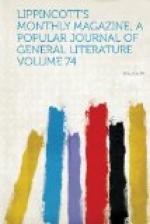The medical witnesses for the defence further called attention to the fact that the symptoms of General Ketchum’s illness were wholly different from those produced by tartar emetic, and some denied that the latter could have caused the sickness. The chemical evidence for the prosecution was triumphantly refuted. It was shown that antimony did not conform in its reactions with at least one of the tests, which Professor Aiken said his precipitates did; that almost all the other reactions could be closely simulated with ordinary organic bodies; that the processes used were those universally condemned by authorities; and that carelessness was everywhere so manifest in their conduction as to entirely vitiate any results. It was also proved that Professor Aiken had simply estimated the amount of tartar emetic in General Ketchum’s stomach by the ocular comparison of the bulk of precipitates, neither of which could have been pure, and in neither of which was the existence of antimony really proved. To weigh a precipitate was a labor not to be thought of when nothing more important than the life of a woman was involved: guessing was all that such a trifling issue demanded!
The most extraordinary event of this most extraordinary trial occurred when the chemists for the defence had completely broken down the testimony of Professor Aiken. With the knowledge, it is said, of at least one of the judges, without the presence of a representative of the defence, or even of a legal officer, the body of General Ketchum was secretly exhumed by the doctors who had shown themselves so eager for the execution of Mrs. Wharton. The viscera, which they removed, were put into the hands not of a chemist of national reputation, but of an individual who had been advanced from the position of hospital steward at Washington to that of professor of chemistry in a small local institute at Baltimore. This professor, when on the witness-stand, was singularly confused as to his weights and measures, and finally shared the ignominy of his predecessor. The defence had several chemists at Annapolis of world-wide reputation and unspotted integrity. If the prosecution really believed that General Ketchum had been poisoned, if they really did expect tartar emetic to be found, why did they not allow the presence of these gentlemen at the analysis, and thereby ensure the condemnation of Mrs. Wharton? The conviction is irresistible that they were afraid of the truth—that they were simply determined to procure the desired verdict at all hazards and by any means. Yet this was the procedure for the completion of which the court suspended the trial for two days, because, as Chief-Justice Miller stated from the bench, “it thought the ends of justice demanded it”! Is any further evidence needed of the strange ideas, of the perversion of truth and justice, which have grown out of the American method of using expert testimony?




